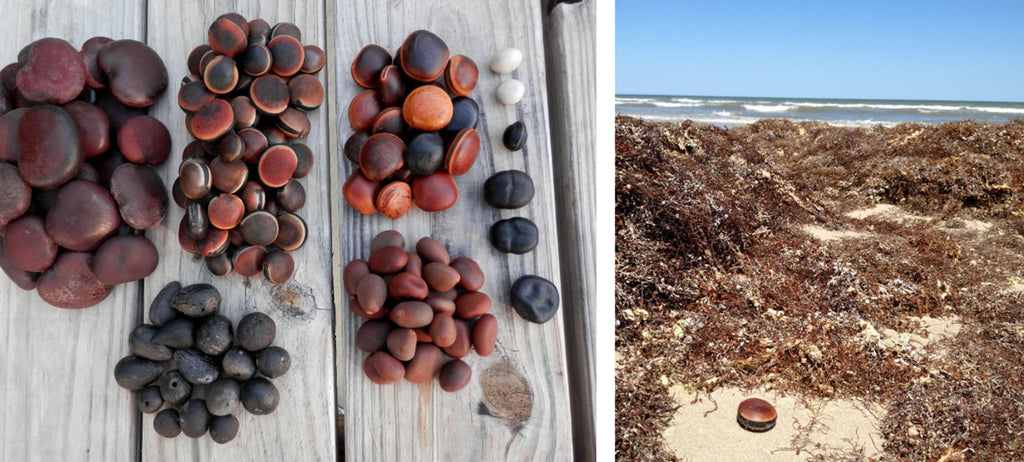Full of Beans
By Kirsti Scott

Mike Ley is a retired engineer from Colorado who became a “Winter Texan” in 2007, spending his summers in Colorado and his winters in South Texas on the Gulf Coast. After 12 years of beachcombing, this self-described avid outdoorsman has walked almost every inch of the 400 miles of coastline in the Lone Star State, both by himself and with his wife, Sandy. But what has him coming back to the same beaches every year? It’s not glass or floats or shells, but something far more uncommon and intriguing: the sea bean.
Sea beans, also known as drift seeds, are the seeds of tropical plants that have evolved to float on water in order to spread to areas not accessible by wind or by animals. Of the 250,000 seed plant species on earth, only about 100 produce drift seeds that can survive in a salt water environment for months or years until they hit land. The seeds fall from trees into rivers or streams, and are eventually taken out to sea where they travel the ocean currents until they are brought to the beach by waves and wind. These plants grow mostly in tropical areas around the world, and those that end up in the eastern United States can come from South and Central America, the Caribbean, and even Africa. Finding sea beans north of the Carolinas is very rare, although there have been some sea beans found near Cape Cod and Nantucket, Massachusetts. “The Texas coast is known to be the best place to hunt for sea beans,” says Mike. And he may be right, as Mike has collected over 25,000 sea beans on the Gulf Coast over the course of his combing career.

The best beachcombing locations on the Gulf, according to Mike, are two secluded beaches in South Texas: South Beach on Padre Island National Seashore and St. Joe’s Island Beach. Both require special transportation to access (four wheel drive vehicle and commercial ferry, respectively), but their remoteness ensures that anyone willing to make the trek will be highly rewarded. Mike loves to be the first one on the beach in the morning and will spend up to three days per week combing for treasures. His personal record was a day in November of 2015 on St. Joe’s Island when he collected 416 collectible sea beans. He has also combed extensively in Louisiana, Florida, Hawaii, Mexico, and the Caribbean, all of whose ecosystems have plant species that came
from drift seeds.

Mike’s own personal favorite sea beans are Cathie’s Beans or Canavalia nitida, the Thick Banded Mucuna or Mucuna elliptica, and the seeds of the Oxyrhynchus genus. On his bucket list is to find a very rare sea bean called the “red horse eye bean,” or Ormosia coutinhoi.

Mike’s collection of 25,000 sea beans is impressive on its own, but he also picks up shells, sea glass, otoliths, fishing lures and floats, duck decoys, trap tags, drift cards, and messages in bottles, some of which have led to new friendships with the senders!
Although he mostly keeps his sea bean collection in buckets and jars, Mike always keeps a few in his pocket in case they ever come up in conversation. He also gives away to expectant mothers the Mary’s Beans, also called Crucifix Beans, which legend tells are passed down from mother to daughter to relieve the pain of childbirth and increase the chances of conceiving.
Mike meticulously records every sea bean he discovers and has calculated the relative rarity of fifteen different sea bean species. The best of the best he puts in “show and tell” boxes to teach others about these amazing seeds. As Mike puts it, “The ones that are interested are impressed with the quantity I have accumulated and the detail of the records I keep. I have met and made many great friends through my sea beaning and beachcombing passion.”

For those wanting to learn more about sea beans, seabean.com and the many sea bean Facebook groups online are a great resource for identifying and sharing sea beans. Mike recommends the book Sea-Beans from the Tropics: A Collector’s Guide to Sea-Beans and Other Tropical Drift on Atlantic Shores, by Ed Perry IV and John V. Dennis, which Mike calls the “Bible of sea beans.” And, if you want to learn even more, take a trip to the International Sea-Bean Symposium held annually in October in either Galveston, Texas, or Cocoa Beach, Florida.
There is so much to love about these evolutionary marvels, and it’s no wonder Mike returns every year to collect them.
This article appeared in the Beachcombing Magazine September/October 2019 issue.
Learn how to identify sea beans found on Texas beaches ›
2 comments
I have 3 of the same kind of sea bean, in my shell collection. Is there a scientific name for these, as I am trying to identyfy allot of my shells, and putting them in compartmented plastic boxes. Is there a family name, genus, and species name or na author & date Any info I can get would be very helpful.
Regards
Walt
I walk the beaches of Bermuda looking for the beans. I think they feel and look great.
I only find the Sea Heart and Hamburger beans on our beaches.
Is their a season as they are not too common and I can not pinpoint a time of year when they are more likely to be found in Bermuda?









